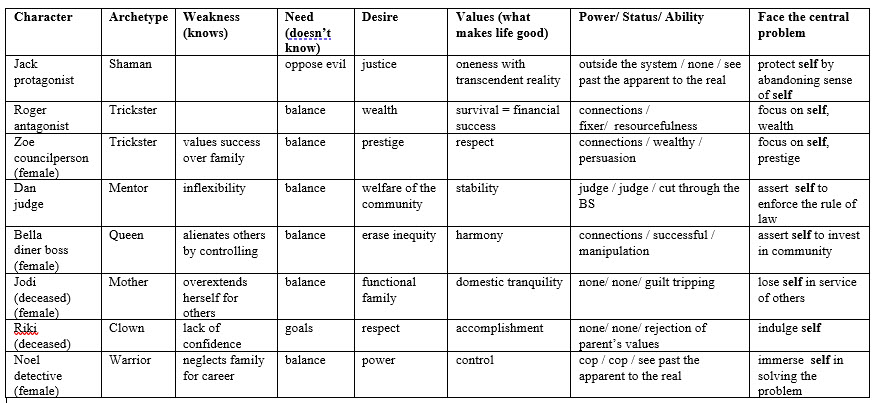We come to what I consider to be the most useful chapter in Truby’s book, developing the characters. A story is only as deep as its characters. Every hour spent on diving deep into character is worth ten hours spent on plot. I’ll go even further and say no plot, no matter how clever, surprising, or shocking can make up for shallow, cliche characters.
I divided my work on this chapter into two posts because it’s so long, and I worked on it for at least two weeks.
I’m intrigued that the concept of self once again emerges as the central problem. In my last novel, The Reluctant Saint, the central moral problem involved self.
Can you lose yourself in love without losing your self?
As I worked through the characters for my new project, a similar theme emerged.
Self preservation can lead to loss of self, self destruction.
Chapter 4: Character Part 1
First I read the chapter and jotted down thoughts that came to me as I considered the various concepts and examples. Then I went back through and worked through the elements.
Thoughts
- Jack seeks the killer to show him how he is harming himself?
- Jack’s back story involves a move from East Texas to Austin in high school. Let’s say his senior year. That’s how he meets Jodi and Riki. And Roger, although Jack doesn’t recognize him at first in present story time.
- What if Roger is the most zen in that he sees no good or evil, and Jack is a reformed zen because he champions good and opposes evil?
- “Often the hero is initially wrong about his true reason for going after the goal and does not discover his real motive until the end of the story, at the self-revelation.” Maybe we tie it all back to The Icebox!
- What if Jack’s range of change goes from speaking in riddles and koans to engaging directly. He’s gliding along on the surface, but he has to abandon the self-preservation of riddles to be real. [Hm, do we need another person whose life is devastated by Jodi’s death? Mother? Sibling? Ex-husband? Friend? Bella?]
- Double reversal? Perhaps Roger is connected to the Icebox story? This could be a wrong turn as it will feel too contrived. But it’s an interesting thought.
- Perhaps Jack’s need is that he has used what he learned from the Icebox to insulate himself from the world. Hm.
- After discovering the murder, Jack must struggle with the problem of inserting himself in the equation, to effect a cause (i.e. to solve the problem). See pp 46+ in Watts to reacquaint yourself with how this works. To clutch instead of to let go.
- Character who is a hoarder ala Hutchison. A clue is hidden in the mountain of papers and cat food tins.
Character List by Function
- Hero: Jack
- Main Opponent: Roger
- Fake-Ally Opponent: Zoe, city councilperson
- Ally: Bella, owns diner? High school friend?
- Fake-Opponent Ally: Dan, judge
- Ally: Jodi and Riki:,high-school friends
- Opponent: Noel, homicide detective
- Subplot Character?
Central moral problem: Self preservation can lead to loss of self, self destruction. (That’s so zen.)
Note: The Atman is self in the sense of the true, supra-individual Self. The Anatman is the realization that the personal self is an illusion.
Archetypes List
- King/Father
- Queen/Mother
- Wise Old Man/Mentor
- Warrior
- Shaman
- Trickster
- Artist/Clown
- Lover
- Rebel
Central problem: Sense of self / loss of self. Paradox: Self preservation can lead to loss of self, self destruction.
Key Point: Be as detailed as possible when listing the values of each character. How does each justify their actions to reach their goal?
Character Web
Notice the recurrence of the self in how each character deals with the central problem, and also how a lack of balance permeates the need for many of the characters. This analysis allows me to compare and contrast how different personalities wrestle with the same issues, which increases the possibility of nuance and richness not only in the characters but also in the plot.
Whether I can pull that off is a completely different question.
[Right-click the image and open it in a new tab or window to enlarge]

Next week we take an in-depth look into what each character values.

